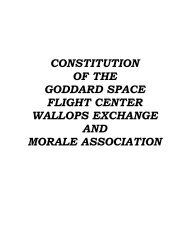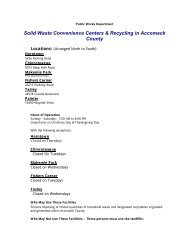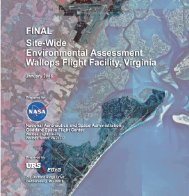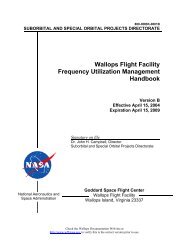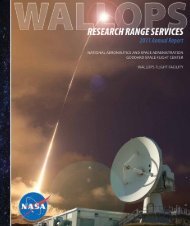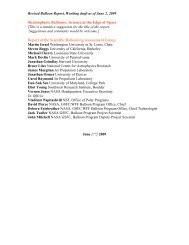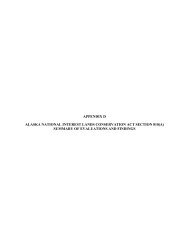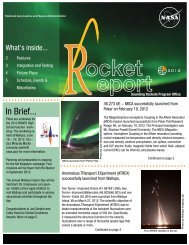Phil Eberspeaker - Wallops Flight Facility - NASA
Phil Eberspeaker - Wallops Flight Facility - NASA
Phil Eberspeaker - Wallops Flight Facility - NASA
Create successful ePaper yourself
Turn your PDF publications into a flip-book with our unique Google optimized e-Paper software.
The Celestial Attitude Control System airbearing test.<br />
22 Sounding Rockets Annual Report 2007<br />
New Program Capabilities<br />
Celestial Attitude Control System (CACS)<br />
The new Celestial Attitude Control System was flight demonstrated to<br />
achieve better than 0.2 arcsec, 1 sigma and 0.5 arcsec Full Width at Half<br />
Maximum (FWHM) pointing precision for<br />
each axis. Key components of this new<br />
ACS include a roll stabilized fiber optic<br />
gyro; a precision fiber optic gyro; a cold gas<br />
linear thrust module; a pitch, yaw and roll<br />
uplink command system; and a 3 axis star<br />
tracker.<br />
In addition to providing gyro drift<br />
compensation, the star tracker provides<br />
celestial reference through its Lost in Space<br />
(LIS) solution. The maneuver algorithm<br />
employed rotates the pointing axis of the<br />
payload along a great circle to science<br />
targets. The successful flight test of this<br />
system, developed in house, enabled<br />
the payload science team to study the<br />
Trifid Nebula in the far-Ultra Violet (UV).<br />
Time to target was much shorter with this<br />
new system and increased science observation time. A re-fly mission<br />
is scheduled to study the Orion Nebula also in the far-UV. Additionally,<br />
flights to study cosmic background radiation and to test a nulling<br />
interferometer designed to detect exo-planets, are planned for the future.<br />
GPS Velocity Vector Attitude Control System<br />
The NSROC Inertial Attitude Control System (NIACS) was modified to<br />
accept GPS inputs and perform computations and control solutions to<br />
allow the payload to remain aligned with the velocity vector throughout<br />
the entire flight. This system also permits attitude corrections during<br />
payload events such as sub-payload and main boom deployments, and<br />
main payload attitude control after boom deploy.



